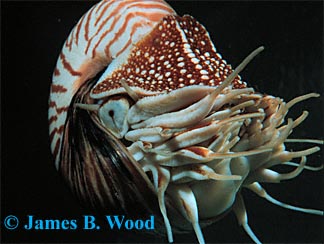
 |
| Home | What's New? | Cephalopod Species | Cephalopod Articles | Lessons | Bookstore | Resources | About TCP | FAQs |
The Perils of the Pearly Nautilus<< Cephalopod Articles | By , Department of Paleontology, Natural History Museum, LondonShell collectors rate those of the pearly nautiluses (Nautilus and Allonautilus spp.) as among the most desirable. They are very familiar even to people who have no idea what the living animal looks like. They are beautifully coloured: a rich cream colour with vivid reddy-brown stripes. Cut in half they are even more dramatic, revealing a unique chambered structure like nothing else in nature.  You can buy these shells in many cities around the world, though the animal itself is confined to the inshore waters of the tropical Indo West Pacific. There are fisheries for nautiluses throughout most of its range, and probably have been for centuries since the animal is eaten by the local peoples, but as it prefers fairly deep water (greater than 150 meters commonly) artisanal fisheries for the animal were probably not a very effective. Also, as the shell is buoyant, after death they can be washed up on beaches and so collected by beachcombers. Undoubtedly many of the older specimens in museums were found in this way. Drift specimens, however, cannot supply the huge market for mint condition shells around the world, and this is where the problem lies. The nautilus happens to live in the waters around parts of the world with rapidly growing populations, for example the Philippines. Rather than being an occasional by-catch the animal is now being specifically hunted for, and using much more durable equipment like nylon ropes it is much easier to fish the deep waters the animal inhabits. One respected nautilus expert has observed that where there was once a thriving nautilus fishery in the Tanon Straits during the mid to late 1970s, the populations appear to have collapsed and few nautilus are caught there any more. The same biologist reports than according to French government scientists, during a ten month period 10,000 nautiluses were caught and exported from New Caledonia. (This figure has been disputed, though, with another correspondent assuring me the figure was much nearer 1000 specimens.) In other places the nautilus fisheries are much smaller and less focused, and the animal is still common, and in Indonesia the animal cannot be legally exported at all. The problem with the nautilus fishery is two-fold. Firstly, there appears to be no hard data on precisely how big the nautilus fisheries are around the world. Many people have seen large numbers of shells for sale, often very cheaply (in London I saw them being sold for 15 UK Pounds, roughly 20 US dollars). It is impossible from hear-say and anecdotal evidence to build up a scientific picture of what sort of shape nautilus populations are in, and whether or not they are being overfished. The second problem is that nautilus are exactly the sort of animal that theoretically would be vulnerable to overfishing. They grow slowly and mature only after several years. Females produce only a few eggs at a time. The history of human exploitation of slowly reproducing animals, e.g. blue whales, African elephants, sharks, etc., is not a good one. Another aspect to this that the nautilus is taxonomically such an interesting animal. It has many local populations which some consider to be species. While some of these live in such remote places they are probably quite safe, others do not, and if these local populations are lost then that is an important loss of diversity. Above all this is the fact that the nautilus is a living fossil, a creature that has essentially remained unchanged in form for millions of years. Animals very similar to the modern nautiluses were swimming the oceans when the dinosaurs walked the Earth, but the heyday of the nautiluses was well before that, around 500 million years ago. Clearly, this is an animal to treasure. Finally, mention needs to be made of nautiluses in captivity. Some public aquaria have kept them with a degree of success, but they almost never lay eggs. As a benchmark, the willingness of animals to reproduce in captivity makes a fair test of whether or not we are keeping them correctly. By this standard, so far we still have much to learn. In domestic aquaria there isn't the justification of finding out about nautilus biology from scientific observation, and the short lives of captive nautiluses is nothing more than a waste. Until we know more about nautilus fisheries and populations, it makes little sense to buy nautiluses alive or dead. Leave them in the sea where they belong.
| ||||||
| Home | What's New? | Cephalopod Species | Cephalopod Articles | Lessons | Resources | About TCP | FAQs | Site Map | |
 |
The Cephalopod Page (TCP), © Copyright 1995-2026, was created and is maintained by Dr. James B. Wood, Associate Director of the Waikiki Aquarium which is part of the University of Hawaii. Please see the FAQs page for cephalopod questions, Marine Invertebrates of Bermuda for information on other invertebrates, and MarineBio.org and the Census of Marine Life for general information on marine biology. |